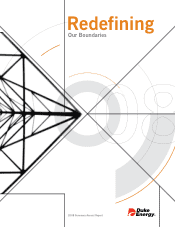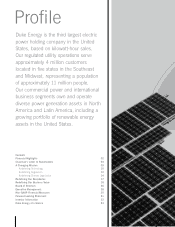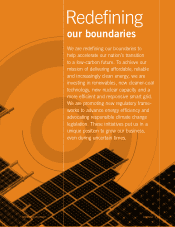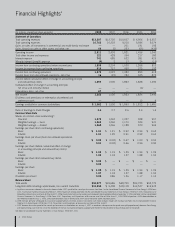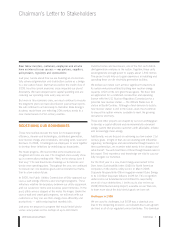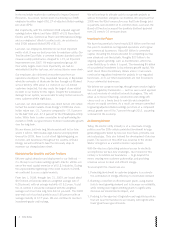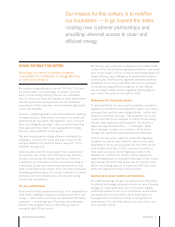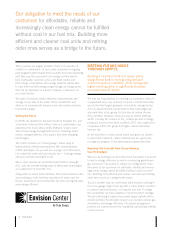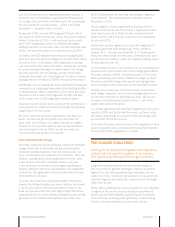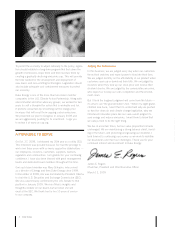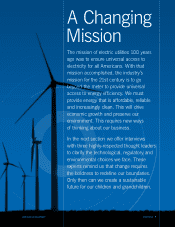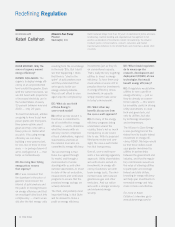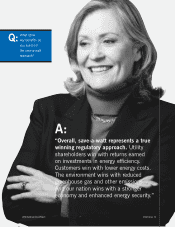Duke Energy 2008 Annual Report Download - page 7
Download and view the complete annual report
Please find page 7 of the 2008 Duke Energy annual report below. You can navigate through the pages in the report by either clicking on the pages listed below, or by using the keyword search tool below to find specific information within the annual report.
2008 Summary Annual Report Duke Energy 5
GOING BEYOND THE METER:
Promoting investment in customer programs
to accelerate the contribution of energy efficiency
to meet future demand.
We consider energy efficiency to be our “fifth fuel.” Of course,
it’s not like water, coal, natural gas or uranium. You can’t
touch or smell energy efficiency, but you can understand
why it is vital to our future. By making our entire system more
efficient, we will save money because we will need fewer
power plants. At the same time, we will maintain high-quality
service and reliability.
However, existing regulations create disincentives for investing
in energy efficiency. Most utilities earn returns on capital only
when they build new plants. But regulators, such as those in
Ohio, are shifting this paradigm. The save-a-watt model they
have approved helps create a level playing field for energy
efficiency and investments in new plants.
The new model promotes energy efficiency investments by
allowing us to recover the money and earn a return on the
savings realized by not having to build a new plant. This is
called the “avoided cost.”
Everyone wins under this new program. Our customers win
because they save money from increased energy efficiency.
Investors win because the returns they earn on efficiency
investments are comparable to those earned by investing in
a new plant. Society and communities win because we will
need to build fewer power plants, which will reduce emissions,
including greenhouse gases. As a result, customers as a whole
will enjoy even more reliable power and new time-saving
services and conveniences.
The Save-A-Watt Model
Save-a-watt is entirely performance-based. If the investments in
more efficient lighting, heating and cooling systems don’t save
energy — which will be verified by an independent third party
every year — we don’t get paid. Customers who participate
directly in the programs could see their bills go down on
average by about $5 per month.
We filed our save-a-watt plan in Kentucky in December 2008.
In early 2009, South Carolina regulators rejected our save-a-watt
plan, but we expect to re-file, as they showed strong support for
energy efficiency and a willingness to expedite their review of
a revised plan. North Carolina regulators requested additional
information on our save-a-watt filing, but they also approved
our proposed energy efficiency programs. In late February
and early March 2009, Indiana regulators held hearings on
save-a-watt. We expect an order later in 2009.
Modernizing Our Distribution System
To fully benefit from our save-a-watt investments, we need to
upgrade our transmission and distribution system. Our nation’s
power grid has used the same analog switches, controls and
meters for more than 100 years. This equipment has served
us well, but it will not be adequate to connect to new energy-
efficient smart appliances and equipment. This requires a
digital two-way interconnection — a “smart grid.” When
this technology is in place, our customers will be able to
manage their appliances and equipment more efficiently.
Over the next five years, subject to constructive regulatory
treatment, we plan to invest about $1 billion in smart grid
equipment in homes and businesses. By mid-2009, we will
have installed more than 70,000 smart electric meters in
three states and about 40,000 digital gas meters in the
Midwest. As I noted earlier, we have received approval to
begin the deployment of smart grid technology in Ohio, includ-
ing installing 700,000 smart meters over the next five years.
We are also seeking approval to install up to 800,000 smart
meters throughout our Indiana service territory.
Maintaining Customer Comfort and Convenience
Smart grid technology will give our customers the opportunity
to optimize their energy consumption while we more efficiently
manage our overall generation load. For example, digitally
connecting appliances such as air conditioners, water heaters
and dishwashers to smart meters allows these devices to
be programmed to briefly turn off and on during times of
peak demand. This will better balance our loads, and in turn,
save customers money.
Our mission for this century is to redefine
our boundaries — to go beyond the meter,
creating new customer partnerships and
providing universal access to clean and
efficient energy.

